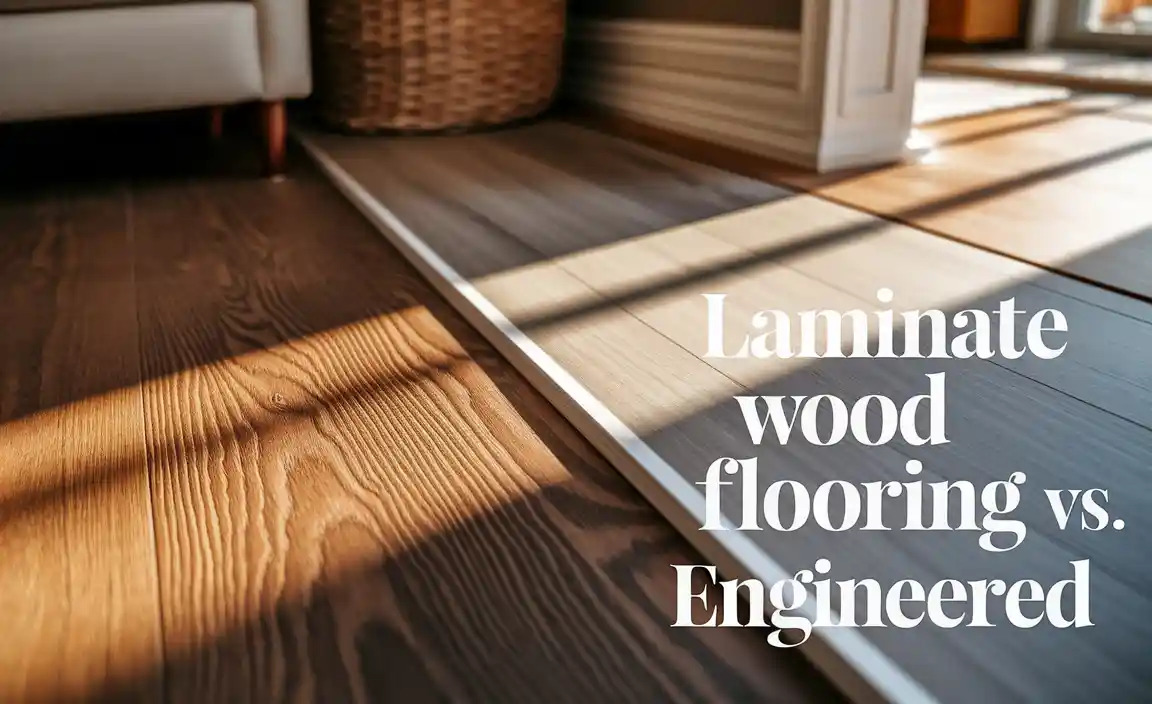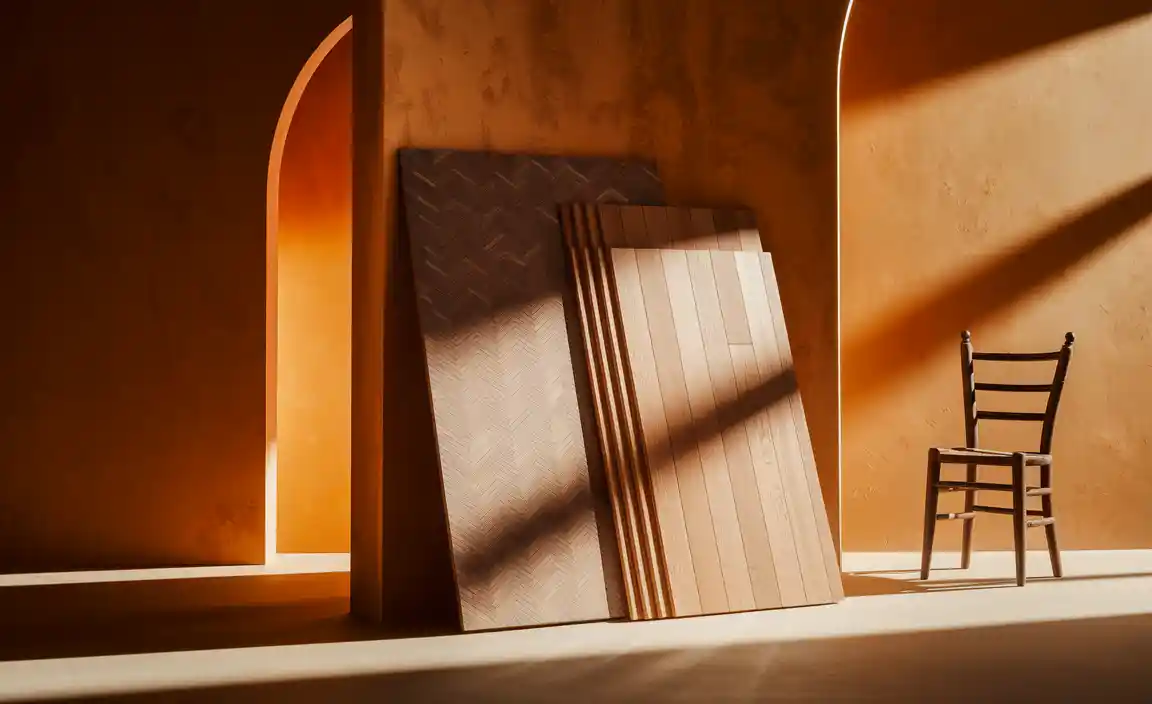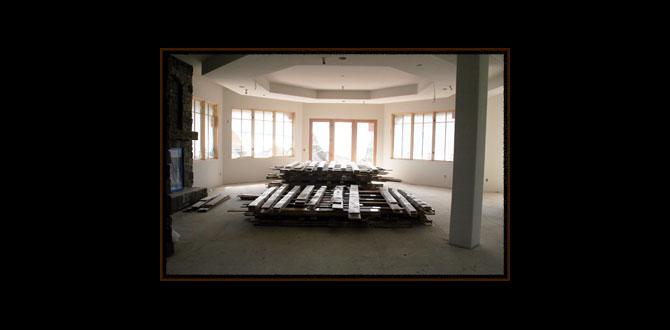Quick Summary: Laminate wood flooring has a printed image layer, making it budget-friendly and imitation-heavy. Engineered wood flooring features a real wood veneer top layer over plywood core, offering genuine wood aesthetics and durability at a mid-range price. Choose laminate for cost-effectiveness and engineered for authentic wood appeal.
Hey there, DIYers! Jack Shaffer here, your go-to guy for all things woodworking and home improvement. Today, we’re diving into a flooring question that pops up more often than you might think: Laminate Wood Flooring vs. Engineered Wood Flooring. It can be a bit confusing, right? They look similar, and sometimes people use the terms interchangeably. But there are some pretty big differences that can impact your project’s look, feel, and even your wallet! Don’t sweat it, though. We’re going to break it all down, step-by-step, so you can make the best choice for your home.
We’ll explore what each type of flooring really is, how they’re made, what their strengths and weaknesses are, and when you might want to pick one over the other. So, grab your favorite beverage, and let’s get your floors sorted!

Table of Contents
Laminate Wood Flooring vs. Engineered: Understanding the Core Differences
When you’re standing in the flooring aisle, trying to decide between laminate and engineered wood, it’s easy to feel a little overwhelmed. They both aim to give you that beautiful wood look, but they get there in very different ways. Think of it like building a sturdy workbench: you can use a really good quality veneer over a strong plywood core, or you can create a convincing wood-look with a high-definition printed image on a durable composite material.

Both have their place, but one is genuine wood, and the other is a clever imitation. The biggest difference lies in their construction. Laminate flooring is essentially a multi-layer synthetic product, while engineered flooring has a real wood top layer. This fundamental difference is what dictates everything from durability and cost to how it feels underfoot and how it can be installed.
What is Laminate Wood Flooring?
Laminate flooring is a manufactured product designed to mimic the look of real wood. It’s built in layers, fused together through a lamination process. Here’s a quick rundown of how it’s typically constructed:
- Wear Layer: This is the top, clear protective layer. It’s typically made of aluminum oxide, which is super hard and resistant to scratches, stains, and fading. It’s the first line of defense that keeps your floor looking good.
- Design Layer: This is where the magic happens for aesthetics. It’s a high-resolution photographic image of wood (or stone, or tile). This layer gives laminate its realistic appearance.
- Core Layer: This is the heart of the plank, usually made from high-density fiberboard (HDF) or medium-density fiberboard (MDF). This layer provides stability and makes the plank rigid.
- Backing Layer: This bottom layer provides stability and moisture resistance. It balances out the plank and prevents it from warping.
Because the “wood” is actually a printed image, laminate flooring can come in an incredible variety of looks. You can find planks that convincingly replicate oak, maple, walnut, or even exotic woods. The quality can vary, but higher-end laminates have very realistic textures to go along with the printed image, making them look and feel quite good.
What is Engineered Wood Flooring?
Engineered wood flooring, on the other hand, is very much a real wood product, just constructed differently than solid hardwood flooring. It’s made from multiple layers of wood or wood composite materials, with a top layer of genuine hardwood veneer.
- Wear Layer (Top Layer): This is a real veneer of hardwood species like oak, maple, hickory, or walnut. The thickness of this veneer determines how many times the floor can be refinished.
- Core Layers: Beneath the hardwood veneer are several layers of plywood, HDF, or solid wood. These layers are cross-grained and glued together. This cross-ply construction is key to the stability of engineered wood.
- Backing Layer: Similar to laminate, a backing layer balances the plank and adds stability.
The beauty of engineered wood is that you get the authentic look and feel of real wood because the top layer is real wood. Each plank will have unique grain patterns and natural variations, just like solid hardwood. The quality and thickness of the top hardwood veneer are major factors in its price and longevity.
Key Differences at a Glance: Laminate vs. Engineered Wood
Let’s put these differences side-by-side. This comparison table should help clear things up:
| Feature | Laminate Wood Flooring | Engineered Wood Flooring |
|---|---|---|
| Top Layer Material | High-resolution printed image of wood | Real hardwood veneer |
| Core Material | High-density fiberboard (HDF) or Medium-density fiberboard (MDF) | Plywood, HDF, or solid wood core |
| Authenticity | Mimics wood appearance | Is genuine wood on the surface |
| Durability | Excellent scratch and fade resistance; can chip | Good scratch resistance; susceptible to dents and moisture depending on veneer thickness and core |
| Water Resistance | Generally low, though some newer options have improved resistance | Varies by product; susceptible to damage from prolonged moisture exposure |
| Refinishing Options | Generally not refinishable | Can be refinished 1-3 times, depending on veneer thickness |
| Installation | Mostly clicked-together, floating floors; DIY-friendly | Can be clicked-together, glued, or nailed; DIY-friendly with click systems |
| Cost | Typically most affordable | Mid-range to high-end, depending on veneer quality |
| Feel Underfoot | Can feel a bit harder or hollow | Feels like real wood; can be softer or more yielding |
| Repair | Individual planks can sometimes be replaced; scratches can be subtle | Scratches and dents can be more noticeable; can be repaired or refinished |
Pros and Cons of Laminate Wood Flooring
Laminate flooring is a popular choice for a reason. It offers a great balance of appearance and affordability. But, like anything, it has its upsides and downsides.
Pros of Laminate Flooring:
- Budget-Friendly: Laminate is typically significantly cheaper than engineered wood or solid hardwood, making it an excellent choice for cost-conscious homeowners.
- Durability and Maintenance: The wear layer is very tough, resisting scratches, stains, and fading from sunlight. It’s also easy to clean – a simple sweep or damp mop is usually all it takes.
- Variety of Styles: The printed design layer means you can find laminate in practically any wood species, color, or pattern imaginable.
- DIY Installation: Most laminate flooring uses a click-lock system, making it a straightforward floating floor installation that’s very beginner-friendly. No need for nails or glue!
- Installation Over Existing Floors: Laminate can often be installed directly over existing hard surface flooring, saving you time and labor.
Cons of Laminate Flooring:
- Not Real Wood: While it looks like wood, it doesn’t have the feel or warmth of real wood. It can sometimes sound hollow when walked on.
- Water Sensitivity: Standard laminate is not waterproof. Spills need to be wiped up immediately, and it’s generally not recommended for bathrooms, laundry rooms, or basements prone to moisture. There are waterproof laminate options, but they come at a higher cost.
- Cannot Be Refinished: Unlike engineered or solid hardwood, you can’t sand down and refinish laminate flooring to repair deep scratches or wear. If the surface layer is damaged, the plank usually needs to be replaced.
- Can Chip: While scratch-resistant, the edges and corners of laminate planks can sometimes chip if heavy objects are dropped on them.
Pros and Cons of Engineered Wood Flooring
Engineered wood flooring offers a premium feel and authentic wood beauty. It’s a significant step up from laminate in terms of natural appeal and value.
Pros of Engineered Wood Flooring:
- Authentic Wood Appearance: The top layer is real wood, so it looks, feels, and even smells like real hardwood. You get natural grain patterns and variations.
- Enhanced Stability: The cross-ply construction makes engineered wood more stable than solid hardwood, meaning it’s less likely to warp, expand, or contract with changes in humidity and temperature. This makes it suitable for more areas of the home.
- Versatile Installation: Engineered wood can be installed using various methods, including floating (click-lock), glued down, or even nailed down, making it adaptable to different subfloors.
- Refinishing Potential: Depending on the thickness of the hardwood veneer, engineered wood can be sanded and refinished one to three times. This significantly extends the life of the flooring and allows you to update the look over time.
- Suitable for More Areas: Due to its stability, engineered wood is often recommended for basements, kitchens, and even some higher-moisture areas, though care must still be taken.
Cons of Engineered Wood Flooring:
- Higher Cost: Engineered wood is generally more expensive than laminate, and often more expensive than lower-end solid hardwood.
- Veneer Thickness Matters: The number of times you can refinish, and the overall durability, depends heavily on the thickness of the real wood veneer. Very thin veneers cannot be refinished.
- Can Still Be Damaged: While durable, the real wood veneer can still be scratched, dented, or damaged by excessive moisture or sharp objects if not cared for properly.
- Installation Can Be More Complex: While click-lock systems are DIY-friendly, glued-down or nailed-down installations require more skill, tools, and preparation.
When to Choose Laminate Flooring
Laminate shines in specific situations where its strengths are most beneficial. If you’re a DIYer looking for a beautiful floor on a budget, laminate is often your best bet.
- Budget-Conscious Projects: This is the primary reason people choose laminate. It offers a high-end look for a fraction of the price of real wood.
- High-Traffic Areas (with caution): The durable wear layer can handle a lot of foot traffic and is resistant to wear and abrasions, making it suitable for busy living rooms or hallways. However, large, heavy furniture can still dent it, and it’s best to avoid areas with very high moisture risk.
- Rental Properties or Flip Houses: When you need a floor that looks good and is easy to maintain without breaking the bank, laminate is a smart investment.
- Kid and Pet Households (with caveats): The scratch and stain resistance is a big plus with pets and kids. Just be diligent about cleaning up spills quickly, as traditional laminate doesn’t love standing water.
- DIY Installation Projects: If you’re new to flooring and want a project you can tackle yourself with minimal fuss, laminate’s click-lock system is hard to beat.
For more information on flooring installation and best practices, check out resources from organizations like the BuildingGreen resource, which provides impartial advice on sustainable building and renovation practices.
When to Choose Engineered Wood Flooring
Engineered wood flooring is the choice when you want the authentic beauty and feel of real wood, but with added stability and versatility compared to solid hardwood.
- Desire for Real Wood Aesthetics: If you absolutely love the look and feel of natural wood grain and want that authentic luxury, engineered wood is the way to go.
- Homes with Variable Humidity: Its layered construction means it’s much more stable in fluctuating temperatures and humidity levels than solid hardwood. This makes it ideal for areas like basements or rooms that experience seasonal changes.
- Kitchens and Dining Rooms: While still vulnerable to major spills, engineered wood can often hold up better than laminate in kitchens where occasional splashes are more common.
- Adding Resale Value: Authentic wood flooring, even engineered, is often seen as a desirable feature that can increase a home’s resale value more than laminate.
- Long-Term Investment: With the ability to refinish, engineered wood can last for decades, making it a worthwhile investment if you plan to stay in your home or want a floor that ages gracefully.
Installation Considerations: Laminate vs. Engineered
When it comes to putting down your new floor, both laminate and engineered wood offer user-friendly installation options, especially the popular click-lock systems.
Laminate Flooring Installation:
Laminate is famous for its “floating floor” installation. This means the planks interlock and lay on top of your subfloor, without being glued or nailed down. This makes it incredibly DIY-friendly.
- Prepare the Subfloor: Ensure your subfloor is clean, dry, and level. Any new flooring needs a good foundation.
- Install Underlayment: A protective underlayment is laid down first. This acts as a moisture barrier, provides cushioning, and helps with sound dampening.
- Lay the Planks: Start in a corner and lay the planks, connecting them using their click-lock system. You’ll typically tap them into place to create a snug fit.
- Cut to Fit: You’ll need to cut planks to fit around doorways, corners, and edges. A jigsaw or miter saw is useful here.
- Add Trim: Once the floor is laid, install baseboards and transition strips to cover the expansion gaps around the perimeter.
Engineered Wood Flooring Installation:
Engineered wood offers more installation flexibility.
- Floating Installation: Many engineered wood floors use a click-lock system, just like laminate. This is the easiest for DIYers and involves laying an underlayment and clicking the planks together.
- Glue-Down Installation: This method involves applying a specialized adhesive to the subfloor and pressing the engineered planks into it. This creates a very solid feel and is often recommended for wider planks or commercial applications.
- Nail-Down Installation: This is more common with thicker veneers and may require professional tools like a flooring nailer or staple gun to secure the planks directly to a wooden subfloor.
Regardless of the method, proper subfloor preparation and acclimatization of the flooring material are critical for a successful installation of either type. For detailed steps, you might look at guides from reputable flooring manufacturers like Coretec or Shaw Floors, which often have videos and detailed instructions.
Caring for Your New Floor
No matter which flooring you choose, proper care will ensure it looks great for years to come.
Caring for Laminate Flooring:
- Sweep or vacuum regularly to remove dirt and grit that can scratch the surface.
- Use a damp, not wet, mop. Standing water can seep into the seams and damage the core.
- Clean spills immediately.
- Use furniture pads on the legs of chairs and tables.
- Avoid using excessive water or abrasive cleaners.
Caring for Engineered Wood Flooring:
- Sweep or vacuum regularly using a soft brush attachment.
- Use a damp mop with a wood-specific cleaner. Avoid excess water.
- Clean spills immediately.
- Use furniture pads on all furniture legs.
- Be mindful of pet nails and high heels, which can scratch the wood veneer.
- Avoid steam mops, as the heat and moisture can damage the wood.
Frequently Asked Questions (FAQ)
Q1: Is laminate flooring waterproof?
A1: Traditional laminate flooring is not waterproof and can be damaged by standing water. However, there are increasingly common “water-resistant” or fully “waterproof” laminate options available, though they are typically more expensive than standard laminate.
Q2: Can engineered wood flooring go in a bathroom?
A2: While more stable than solid hardwood, engineered wood is still susceptible to water damage. It’s not ideal for full bathrooms prone to heavy moisture or standing water. Water-resistant or waterproof options are better suited for these areas.
Q3: Which is more durable,


